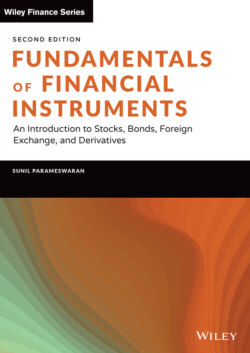Читать книгу Fundamentals of Financial Instruments - Sunil K. Parameswaran - Страница 70
На сайте Литреса книга снята с продажи.
EXAMPLE 2.1
ОглавлениеTake the case of an investment in a Treasury security with a face value of $1,000. Assume that it will pay $100 by way of interest every year. When the security is acquired, the price of a box of chocolates is $10, and we will assume that the price remains the same until the end of the year. Consequently, the investor can expect to buy 10 boxes after a year when he receives the interest.
In this example, the rate of interest in terms of dollars is 10% per annum, since an investment of $1,000 yields a cash flow of $100. In terms of goods, which in this case is chocolates, our return is also 10%, for the principal corresponds to an investment in 100 boxes of chocolates and the interest received in dollars facilitates the acquisition of another 10 boxes. The rate of interest as measured by our ability to buy goods and services is termed as the real rate of interest.
In real life, however, price levels are not constant, and inflation is a constant fact of life. Assume that the price of chocolates after a year is $12.50. If so, the $100 of interest that will be received as cash will be adequate to buy only eight boxes of chocolates. The principal itself will be adequate to buy only 80 boxes of chocolates, which means that the investor can acquire only 88 boxes in total. Thus, while the return on investment in terms of money is 10%, in terms of the ability to buy goods, it is –12%.
Assets such as Treasury securities give us returns in terms of money, without any assurance as to what our ability to acquire goods and services will be at the time of repayment. The rate of return yielded by such securities in dollar terms is termed as the nominal, or the money rate of return. In our illustration the investor got a 10% return on an investment of $1,000. In the situation where the price of a box of chocolates remained at $10, the ability to buy chocolates was enhanced by 10% and consequently the real rate was also 10%. However, when the price of chocolates rose to $12.50 per box, an initial investment of $1,000, which represented an ability to buy 100 boxes of chocolates at the outset, was translated into an ability to buy only 88 boxes at the end of the year. Thus, the real rate of return in this case was negative or was –12% to be precise.
The relationship between the nominal and real rates of return is called the Fisher Hypothesis, after the economist who first postulated it.
